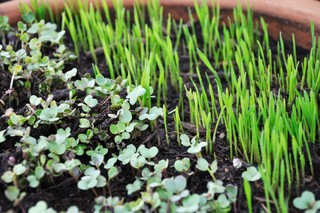Microgreens 101: How to grow microgreens at home

Microgreens have been a staple of the culinary world for the last decade, showing up to add dazzling color and a punch of bright flavor to dishes. Growing microgreens at home might sound like a fun project, a way to supplement a healthy diet, or even a potential business opportunity.
One thing is certain: starting a miniature indoor garden is an excellent way to develop and cultivate a green thumb.
To grow microgreens at home you need a seed tray, growing medium (soil or soilless), and seeds. Keep the tray in a sunny location, water often, and within 7-21 days you’ll have delicious, nutritious microgreens ready for harvest.

How to grow microgreens at home
A few critical components are required to grow your own microgreens: growing medium, growing trays, and a grow light. These are the variables in a setup that can be experimented with and improved over time. Read on for an at-length explanation of each item needed for microgreen cultivation.
Supplies Needed:
Growing Trays
There is no hard and fast rule for what microgreens can be grown in. We recommend a microgreen tray for beginners, any brand works, but our favorites are on Amazon here.
There are specially-designed trays for microgreens with clear lids for retaining moisture, but plenty of hobbyists have started out using the plastic clamshells that produce or takeout meals come in. For long-term growing, sturdy plastic trays with drainage holes are optimal. A one-inch deep tray is plenty deep to grow them.
Growing Medium
One of the most important decisions to make is what type of growing medium to use. Some growers swear by potting soil; others prefer soilless medium, like coconut coir. If you’re going the soil route for your microgreens, we recommend Fox Farm for potting soil. It can be found on Amazon, or at some local gardening centers.
It is also possible to make a customized potting mix at home. Experimenting to find what works best for you is always a good policy, and learning about what makes an excellent growing medium never hurts either.
To learn more about the best substrate for container-grown herbs, read our post on growing media.
Certified Organic Seeds
As discussed above, using certified organic seeds will be the safest and best option. Buying in bulk will keep costs down, but a good policy is to test a few varieties before going all-in on a large volume of seed.
Grow Light
There are many affordable and effective lighting options out there. A good 30 watt LED setup will provide enough light to support a fully indoor microgreen crop. Studies have shown that moderate light will grow exceptional microgreens.[1]
Bear in mind that a sunny, south-facing window is often an excellent place to start experimenting with growing microgreens. 4-8 hours of direct light per day is necessary for healthy growth.
This is our favorite growing light available for purchase here on Amazon.
Spray Bottle or Watering Can
Believe it or not, this one is a little controversial. Spritzing emerging seedlings is encouraged by some growers and discouraged by others who prefer using a watering can to water from below (more on that in the next section). Every setup is a little different and will take trial and error to get right.
Labeling Materials and Notebook
While not necessary initially, the benefits of record keeping are vast. Knowing what worked and understanding germination rates are beneficial tools if this becomes a long-term endeavor.

The enthusiast's guide to herbs
We’re proud to present our new e-book, The Enthusiast’s Guide to Herbs! Learn everything you need to know about growing and caring for herbs indoors, including in-depth info cards for the 35 most commonly grown herbs.
Click the link below to find out more!
Step-By-Step Instructions
Once you’ve collected supplies, getting started should be easy. Following these simple steps will help to ensure success:
-
Secure a Location
Clear the area where microgreens will be grown and ensure that the surface is protected from overspray from misting or overflow from drain holes.
-
Prepare Growing Trays
If re-using a container, make sure it is disinfected and dry. Fill trays with an inch or so of moist (but not wet) growing medium and make the soil level by dragging or pressing a piece of cardboard across the soil surface.
-
Prepare and Sow Seeds
Seeds that benefit from soaking (usually larger seeds or seeds or seeds with a tough hull) should be soaked overnight or for a few hours before sowing. Spread seeds evenly over the entire surface of the soil, and sprinkle a little bit of soil/growing medium over them.
-
Press Seeds into Soil
Pressing seeds into the soil helps them establish good soil contact, which allows them to absorb more moisture and encourages germination and growth. If using trays that are the same size, it is possible to stack them on top of one another to apply uniform pressure across the entire soil surface.
-
Cover and Wait
Trays that come with moisture domes should be covered at this point, while stackable trays can be stacked to create a moisture-dome effect. Many seeds require no light to germinate–what they need is moisture–so stacking trays isn’t a problem. Some growers will cover trays with a plastic bag or plastic wrap to encourage germination in the beginning.
-
Water as Needed
Trays that are uncovered or in a sunny windowsill will need to be misted at least once a day with a spray bottle. Remember, the important thing is to keep the seeds moist, but not wet, until they germinate. Once the seeds have sprouted, spraying once or twice a day is recommended.
-
Harvest and Enjoy
Once the microgreens are a few inches high and have developed a set of true leaves, they are ready to harvest. Using sharp scissors, snip the stems just above the soil line. If it is necessary to rinse them, gently dry them in a salad spinner or on a paper towel.
Alternative: Hamama microgreen kit

If you’re having trouble starting your microgreen garden, then Hamama microgreen trays are a great option. They come with a “seed quilt” pre-packed with the green variety of your choice, and you simply add water to the shallow tray. Then sit back and watch your greens grow.
You can learn about Hamama and purchase a kit here; you can also find it here on Amazon. It’s currently a fixture of my kitchen, and it makes growing microgreens extremely simple. For more information check out our full hands-on review.
What are microgreens?
Everyone knows what sprouts are, right? Microgreens are the sprout’s sophisticated older cousins. While sprouts are grown without growing medium and are eaten roots and all, microgreens are cultivated in a growing medium and are trimmed at the base and consumed.
Microgreens are harvested when they’re a couple of weeks old and have developed their first set of true leaves. On the other hand, sprouts are eaten just as their cotyledons– the first set of leaves that emerge from the seed– become green. Microgreens take a little longer to grow than sprouts but are lower-maintenance.
Considered a superfood, these baby greens are full of health benefits and radically outperform their mature counterparts in antioxidants. A University of Maryland study clocked the nutritional value of microgreens at four to forty times their mature versions.[2]
Due to their delicate structures and short shelf life, these tasty treats are typically reserved as garnishes in high-end restaurants. However, because they are easy to grow and require little space, they are a perfect crop to grow year-round at home.
Why grow your own microgreens?
There are so many reasons to grow microgreens at home, but the primary reasons are:
- Easy to grow in a limited amount of space.
- Quick turnaround– even if a crop is unsuccessful, little time and resources will have been lost, and starting over is straightforward.
- An inexpensive way to have a continuous supply of fresh, high-density nutrient greens at home.
- A great introduction to gardening for beginners.
- No climate restrictions due to a controlled, indoor environment.
- Incredibly healthy, living food to supplement a healthy diet.
You can add microgreens to almost any dish, including soups and smoothies. Try adding them on top of your next meal for a fresh crunch of flavor!

Growing Tips
- The most common problem faced by microgreen growers is fungus. Spraying water excessively onto the growing surface can encourage mold growth, which will ruin a crop. For this reason, some growers prefer bottom watering– using a growing tray with drainage holes and letting water infiltrate up from a solid tray below that has been filled with water.
- Washing microgreens shortens their already brief shelf life, so the best policy is to cut only what you need and cut high enough above the soil line that no rinsing is required. This is one of the most beautiful things about producing your own microgreens at home– never having to worry about what nasty chemicals or fertilizers have been applied to your food.
- After harvesting microgreens, treat them like cut flowers when storing. Place the cut ends of the stems into a shallow container of water and place it in the fridge for later. Microgreens stored in this way can last up to a week.
What can be grown as a microgreen?
While the varieties of microgreens seen in grocery stores are pretty limited to those with a longer shelf life, the range of plants that can be grown as microgreens is surprisingly vast. Commonly grown microgreens include salad greens, leafy vegetables, edible flowers, herbs, and even some root veggies.
The easiest microgreens to grow have large seeds; a smaller type of seed is trickier.
Large microgreen seeds
These varieties tend to be very easy to grow, but plant density will be lower due to the larger seed size. However, the plants themselves tend to be somewhat larger, and stouter microgreen yields are produced from these large seeds. Most of these can do with a presoak before sowing.
Commonly grown large seed microgreens include beets, chard, cilantro, dill, fennel, kale, parsley, pea shoots, sunflower, and wheatgrass.
Medium microgreen seeds
These varieties will be simple to grow, and many of them benefit from a presoak, although it isn’t necessary unless specified. These will have a higher plant density per tray than larger microgreens.
Commonly grown medium microgreen seeds include arugula, basil, broccoli, cabbage, chia, mustard, radish, spinach, and turnip.
Small microgreen seeds
These tiny seeds, many of them from herbs, are a little more challenging to grow because of the difficulty in sowing them evenly across the planting medium. Nonetheless, they will form a very dense mat of plants if sown heavily and, with the exception of alfalfa, are packed with intense flavors.
Commonly grown small microgreen seeds include alfalfa, amaranth, celery, mint, oregano, sage, and thyme.

Join our email club—get printable info cards free!
Sign up to receive our newsletter and get access to 10 printable plant info cards from our e-book for free. Also receive:
- $4 discount code for our Guide to Herbs e-book
- Semi-weekly plant inspiration & bite-size tips and tricks
FAQ
Do microgreens regrow after cutting?
Yes, some microgreens grow back after cutting or harvesting the tops, but not all types. Most types are a “one and done”, meaning that after you harvest them the first time they stop growing. However plants like beans, peas, and kale may grow back after harvesting, especially if you leave at least one healthy leaf.
Can I reuse potting soil for microgreens?
Yes, you can reuse potting soil after a batch of microgreens. Some people opt to simply turn the potting soil over, or mix it up, breaking up any clumps that may have formed. If you choose to reuse the media continuously, it would benefit from sterilization. For more information read our post on sterilizing soil.
Can you use old seeds to grow microgreens?
Yes, you can use older seeds to grow microgreens. Since you are planting at such a dense rate, the germination percentage isn’t as crucial as when planting a couple seeds, so it’s not as important if the viability is lower. Because of this, some people specifically use older seeds to grow microgreens instead of throwing the seeds away.
Samuolienė, Giedrė, Aušra Brazaitytė, Julė Jankauskienė, Akvilė Viršilė, Ramūnas Sirtautas, Algirdas Novičkovas, Sandra Sakalauskienė, Jurga Sakalauskaitė, and Pavelas Duchovskis. 2013. “LED Irradiance Level Affects Growth and Nutritional Quality of Brassica Microgreens.” Open Life Sciences 8, no. 12: 1241–49. ↩︎
Xiao, Zhenlei, Gene E. Lester, Yaguang Luo, and Qin Wang. 2012. “Assessment of Vitamin and Carotenoid Concentrations of Emerging Food Products: Edible Microgreens.” Journal of Agricultural and Food Chemistry 60, no. 31: 7644–51. ↩︎
